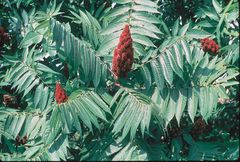Rhus typhina: Difference between revisions
No edit summary |
No edit summary |
||
| Line 1: | Line 1: | ||
{{SPlantbox | |||
|Min ht metric=cm | |||
|Temp Metric=°F | |||
|jumpin=This is the plant information box - for information on light; water; zones; height; etc. If it is mostly empty you can help grow this page by clicking on the edit tab and filling in the blanks! | |||
|image=Upload.png | |||
|image_width=240 | |||
}} | |||
{{Inc| | |||
Rhus typhina, Linn. (R. hirta, Sudw. Schmaltzia hirta, Small). | |||
Staghorn Sumac. Fig. 3398. Shrub or tree, to 30 ft.: branchlets | |||
densely velvety-hairy: lfts. 11-31, oblong-lanceolate, pointed, | |||
serrate, glaucescent beneath, 2-5 in. long: fls. greenish, in dense | |||
terminal panicles: fr. crimson, hairy. June, July; fr. Aug., Sept. Em. | |||
571. s.S.3:102,103. Gn. 54, p. 505. G.F. 2:343 (adapted in Fig. 3398). | |||
Que. to Ont., south to Ga., Ind., and Iowa. Var. laciniata, Wood. | |||
Lfts. and bracts deeply and laciniately toothed and the infl. | |||
sometimes partly transformed into contorted bracts. Var. dissecta, | |||
Rehd. (var. laciniata, Hort.). Fig. 3399. Lfts. pinnately dissected. | |||
M.D.G. 1900:211. G.M. 53:827. R.H. 1907, pp. 10, 11. A very handsome | |||
form with finely cut foliage. R. typhina filicina, Sprenger, is | |||
probably not different.—The staghorn sumac grows in the driest soils | |||
and is a very desirable plant on account of its brilliant fall | |||
coloring, which in dry localities begins to show in Aug., and with its | |||
crimson fr.-clusters persisting through the winter. Trained in tree | |||
form it is very picturesque, but is short-lived. | |||
}} | |||
{{Taxobox | {{Taxobox | ||
| color = lightgreen | | color = lightgreen | ||
Revision as of 06:08, 16 December 2009
| subsp. var. | ||||||||||||||||||||||||||||||||||||||||||||||||||||||||
|---|---|---|---|---|---|---|---|---|---|---|---|---|---|---|---|---|---|---|---|---|---|---|---|---|---|---|---|---|---|---|---|---|---|---|---|---|---|---|---|---|---|---|---|---|---|---|---|---|---|---|---|---|---|---|---|---|

|
|
| ||||||||||||||||||||||||||||||||||||||||||||||||||||||
| ||||||||||||||||||||||||||||||||||||||||||||||||||||||||
| Standard Cyclopedia of Horticulture |
|---|
Rhus typhina, Linn. (R. hirta, Sudw. Schmaltzia hirta, Small). Staghorn Sumac. Fig. 3398. Shrub or tree, to 30 ft.: branchlets densely velvety-hairy: lfts. 11-31, oblong-lanceolate, pointed, serrate, glaucescent beneath, 2-5 in. long: fls. greenish, in dense terminal panicles: fr. crimson, hairy. June, July; fr. Aug., Sept. Em. 571. s.S.3:102,103. Gn. 54, p. 505. G.F. 2:343 (adapted in Fig. 3398). Que. to Ont., south to Ga., Ind., and Iowa. Var. laciniata, Wood. Lfts. and bracts deeply and laciniately toothed and the infl. sometimes partly transformed into contorted bracts. Var. dissecta, Rehd. (var. laciniata, Hort.). Fig. 3399. Lfts. pinnately dissected. M.D.G. 1900:211. G.M. 53:827. R.H. 1907, pp. 10, 11. A very handsome form with finely cut foliage. R. typhina filicina, Sprenger, is probably not different.—The staghorn sumac grows in the driest soils and is a very desirable plant on account of its brilliant fall coloring, which in dry localities begins to show in Aug., and with its crimson fr.-clusters persisting through the winter. Trained in tree form it is very picturesque, but is short-lived.
|
| Rhus typhina {{{status}}} Fossil range: {{{fossil_range}}}
| ||||||||||||||||||||||||||||||||||||||||||||||||||||||||||||||||||
|---|---|---|---|---|---|---|---|---|---|---|---|---|---|---|---|---|---|---|---|---|---|---|---|---|---|---|---|---|---|---|---|---|---|---|---|---|---|---|---|---|---|---|---|---|---|---|---|---|---|---|---|---|---|---|---|---|---|---|---|---|---|---|---|---|---|---|
 Staghorn sumac | ||||||||||||||||||||||||||||||||||||||||||||||||||||||||||||||||||
| Plant Info | ||||||||||||||||||||||||||||||||||||||||||||||||||||||||||||||||||
| ||||||||||||||||||||||||||||||||||||||||||||||||||||||||||||||||||
| Scientific classification | ||||||||||||||||||||||||||||||||||||||||||||||||||||||||||||||||||
| ||||||||||||||||||||||||||||||||||||||||||||||||||||||||||||||||||
| [[{{{diversity_link}}}|Diversity]] | ||||||||||||||||||||||||||||||||||||||||||||||||||||||||||||||||||
| {{{diversity}}} | ||||||||||||||||||||||||||||||||||||||||||||||||||||||||||||||||||
| Binomial name | ||||||||||||||||||||||||||||||||||||||||||||||||||||||||||||||||||
| Rhus typhina L. | ||||||||||||||||||||||||||||||||||||||||||||||||||||||||||||||||||
| Trinomial name | ||||||||||||||||||||||||||||||||||||||||||||||||||||||||||||||||||
| {{{trinomial}}} | ||||||||||||||||||||||||||||||||||||||||||||||||||||||||||||||||||
| Type Species | ||||||||||||||||||||||||||||||||||||||||||||||||||||||||||||||||||
| {{{type_species}}} | ||||||||||||||||||||||||||||||||||||||||||||||||||||||||||||||||||
| {{{subdivision_ranks}}} | ||||||||||||||||||||||||||||||||||||||||||||||||||||||||||||||||||
| [[Image:{{{range_map}}}|{{{range_map_width}}}|]] | ||||||||||||||||||||||||||||||||||||||||||||||||||||||||||||||||||
| Synonyms | ||||||||||||||||||||||||||||||||||||||||||||||||||||||||||||||||||
| {{{synonyms}}} |
Staghorn Sumac (Rhus typhina, synonym: R. hirta), is a deciduous shrub to small tree in the Anacardiaceae or Cashew family, native to eastern North America, from Ontario and Quebec south to northern Georgia and Mississippi [1].
It grows to 3-10 m tall, and has alternate, pinnately compound leaves 25-55 cm long, each with 9-31 serrate leaflets 6-11 cm long [2]. The leaf petioles and the stems are densely covered in rust-colored hairs.
The fruit of staghorn sumac is one of the most identifiable characteristics, forming dense clusters of small red drupes at the terminal end of the branches [2]; the clusters are conic, 10-20 cm long and 4-6 cm broad at the base. The plant flowers from May to July and fruit ripens from June to September. [1] The foliage turns a brilliant red in autumn. Sumacs are considered some of the best fall foliage around. The fruit has been known to last through winter and into spring.
Staghorn sumac spreads using its seeds, and by spreading rhizomes. This makes it so the tree forms colonies, with the oldest plants in the center, and the younger plants radiating out [2]. It grows quite aggressively.
Cultivation and uses
Staghorn sumac grows in gardens, lawns, the edges of forests, and wasteland. It can grow under a wide array of conditions, but is most often found in dry and poor soil on which other plants cannot survive [2].
The fruit of sumacs can be collected, soaked and washed in cold water, strained, sweetened and made into a good pink lemonade [3]. The leaves and berries of staghorn sumac have been mixed with tobacco and other herbs and smoked by Native American tribes [4]. This practice continues to a small degree to this day [4].
The cultivar 'Laciniata', Cutleaf Staghorn Sumac, is grown in gardens as an ornamental plant.
Photographs
-
Male flower cluster
-
Ripening drupes on June 11, 2007
-
Dried "male" flower cluster on June 22, 2007
-
Fall colors
References
Template:Commons Template:Wikispecies
- [1] Germplasm Resources Information Network: Rhus typhina
- [2] Richard H. Uva, Joseph C. Neal and Joseph M. Ditomaso, Weeds of The Northeast, (Ithaca, NY: Cornell University Press, 1997), Pp. 326-327.
- [3] Lee Allen Peterson, Edible Wild Plants, (New York City: Houghton Mifflin Company, 1977), P. 186.
- [4] Cowasuck Band of the Pennacook-Abenaki People: The People of the White Pines: Smoking and Pipes
- Bioimages: Rhus typhina (as R. hirta)



